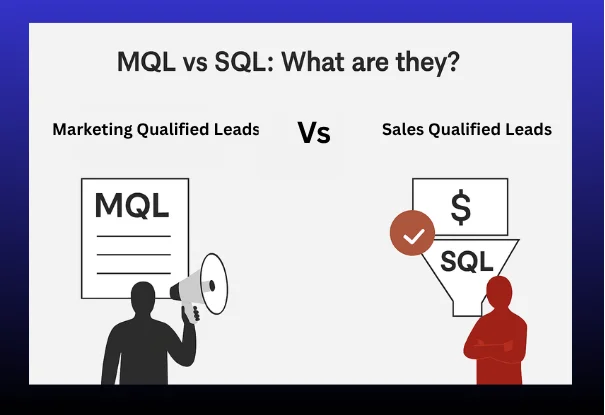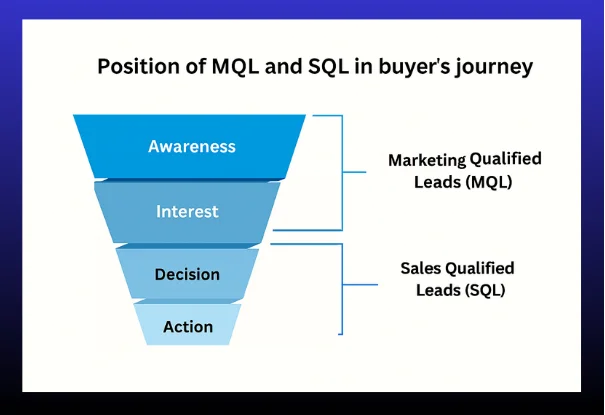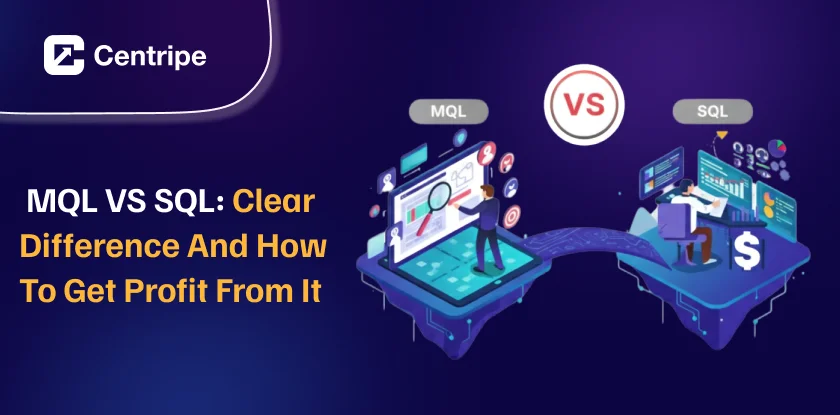The marketing team says, ‘This lead is ready!’
But when the sales team calls…. The person is not interested or is just browsing.
The truth?
This happens because marketing and sales have different ideas of what ‘‘ready to buy’’ means. That misunderstanding wastes time, effort and money.
That’s why knowing the difference between an MQL vs SQL (sales qualified leads) matters. In simple terms:
MQL: Someone interested but not ready to buy.
SQL: Someone ready to talk about buying.
Knowing this much is not enough…
Therefore, this guide is made to help you see the difference between MQLs & SQLs in detail so you don’t miss out on any good leads.
MQL vs SQL: What are they?

Before knowing the difference between MQLs and SQLs, let’s first understand them individually.
What is a Marketing Qualified Lead (MQL)?
A Marketing Qualified Lead is someone who shows interest in what you offer but is not ready to buy yet. They are like curious window shoppers who have actually walked into your store. Looking around but have not decided to buy yet.
What is a Sales Qualified Lead (SQL)?
A Sales Qualified lead is someone who is ready to buy. They know what they want, have the money to spend, and have a timeline to decide. They’ve done their research and are now comparing the options.
The Actual Difference Between MQL and SQL?
Let’s be honest. The difference between MQLs and SQLs goes far beyond simple labels.
This difference makes a huge change in how your whole sales and marketing team works. Here’s what really matters:
Intent and readiness to buy:
- An MQL is still in research mode, interested in learning and exploring options, but not yet ready to buy.
- An SQL, on the other hand, is in buying mode. They are actively comparing you with competitors, asking for specific details to make a purchase decision.
Engagement and behaviour:
- MQLs usually consume a few educational pieces of content, read blogs, or attend webinars. They might visit your site for short periods and are often just one person who is exploring options.
- Whereas SQLs engage more deeply and often by exploring multiple types of content. They spend longer on your site, and often involve people from their company in the process.
Typical Questions:
- MQL asks broad questions to understand the problem and market. Such as ‘Why is this not working?’ or ‘What are others doing in this space?’.
- An SQL lead, on the other hand, asks specific questions about how the product or service meets their specific needs and when it can be put into action.
Positions in the buyer’s journey:

- MQLs are in the early or middle stages of their buying journey. They’re trying to understand their problem, see what solutions exist, and figure out what they should look for.
- SQLs are in the final decision stage. They have done their research and are now focused on how your product solves their specific problem.
Email Interaction:
- An MQL lead usually reads marketing emails and clicks on links to gather more information, but they don’t often reply back.
- However, SQL lead is a more active role in communication. They usually reply to sales emails and ask detailed questions or ask for more information.
Website behaviour:
- An MQL lead usually spends only a short amount of time on the website, by mostly browsing informational pages. They are trying to learn about the product or topic and get a general understanding.
- Whereas SQL spends significant time exploring the website, focusing on pages that provide specific product information. This deeper exploration demonstrates their intent to evaluate whether the solution fits their needs.
Time spent:
- An MQL typically visits for 5 to 10 minutes during preliminary research. These visits are focused on gathering foundational information.
- Whereas an SQL invests 15 or more minutes exploring multiple pages deeply. These visits indicate they are seriously considering the product and weighing it against other options.
How to Smoothly Move leads from Marketing to Sales?
This is the make-or-break moment. The move from MQL to SQL is critical; if it goes wrong, you’ll lose the lead. Let’s make sure that doesn’t happen.
Step 1: Define clear ‘Qualification criteria’
An MQL is someone who fits your target customers, has real contact details, and has shown interest through a few key actions, scoring 75+ points.
SQL is warmer, they score over 100, take serious steps like requesting a demo, replying to sales, and meet basics like budget and decision-making power.
Step 2: Use Lead scoring the smart way
- Content downloads (+5), Webinars (+15), Demo requests (+50), Pricing page visits (+25)
- C-level role (+30), right industry (+20), company size (+15), Geographic match (+10)
Step 3: Create a simple handoff flow
The step involves making the handoff process fast and clear to keep everything running smoothly. It means leads don’t get lost, wasted, or ignored. Both teams know exactly what to do, who is responsible, and how to quickly act.
Steps to make the handoff fast and smooth:
- Marketing qualifies the leads
- The system sends an immediate alert
- Marketing shares a quick lead summary
- Sales review the lead within 4 hours
- Sales makes contact within 24 hours
- Feedback loop back to marketing
Step 4: Route leads to the right team
Not every lead can be handled by the same sales team. Such as:
- Large companies should go to the senior sales team.
- Mid-sized companies should work with the regional sales team.
- The inside sales team works best for small businesses.
Step 5: Track and improve
The last and final step involves monitoring key metrics to keep the process sharp.
- 25-30% of MQLs should become SQLs
- Over 80% of SQLs should be accepted by sales.
- Sales should try to contact leads within 24 hours.
- 40-50% of SQLs should turn into real opportunities.
- Sales should give feedback on every lead within 48 hours.
Conclusion
The companies winning today aren’t always the biggest or the most popular overnight. They have finally cracked, which leads to follow and when.
In other words, they have mastered the MQL and SQL game.
When this is done well, the whole process runs smoothly. Marketing finds good leads, sales talks to the right people, and the business grows faster without spending too much time or money.
But remember… what works today might not work next quarter. Keep testing, keep refining, and keep the conversation open between teams.
